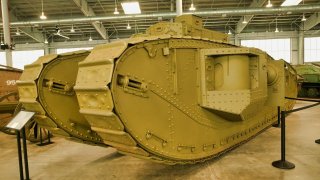Mark VIII: The Original U.S. Army Tank Has Come Home
While it arrived too late to see service in World War I, the Mark VIII or Mk VIII has still been seen as the forerunner of American tanks to follow.
What makes the Mark VIII or Mk VIII such a special tank: During World War I, the United States military operated a total of 144 French-designed and built Renault FTs. However, the tank was also produced by the United States as the M1917 in the fall of 1918—but the first completed models only arrived in France after the end of the hostilities.
Even as it was likely clear to some military planners that the smaller French FT, which featured a rotating turret, was the future of tank designs, an Anglo-American effort moved forward to build the Mark VIII “Liberty Tank.” Though similar to the British-built rhomboid tanks—which were notable for their full-length high tracks and side sponsons housing 6-pounder (57mm) guns—the Mk VIII went on to become the first tank to have truly American DNA, and a total of 124 were produced at the Rock Island Arsenal in Rock Island, Illinois, between 1919 and 1920.
As noted by the arsenal, each weighed about 40 tons, and had a height of more than 10 feet. In addition to the two 57mm guns, the tank was also armed with five M1917 Browning water-cooled machine guns. Each was operated by a crew of eight.
“The MK VIII is an important stepping stone in armored history for two reasons: First, it represents the U.S. Army’s full commitment to fielding and supplying a heavy tank component of its fledgling armored branch of service,” said military vehicle historian John Adams-Graf, editor of History in Motion, the journal of the Military Vehicle Preservation Society.
The tank was truly an international effort, as the armor plates were made in England, while the United States designed the power plant—including the engine, transmission, and steering components. The original plan called for it to be built at a factory in France, possibly with Chinese labor! The tank was to have been used in the planned 1919 offensive, but the war ended before that was necessary.
“It represents an early cooperative effort between allies to field ‘universal’ weaponry,” Adams-Graf told The National Interest. “Great Britain and the U.S. entered into a working agreement where Great Britain would furnish the hulls, guns, and ammunition while the U.S would provide the powerplants and drivetrain. In so doing, they believed that supplying and maintaining the tanks in the European war would be more efficient than both nations developing their own heavy tanks.”
A Restored or Mark VIII or Mk VIII Tank
While it arrived too late to see service in World War I, and it was hopelessly obsolete by even the end of the 1920s, the Mk VIII has still been seen as the forerunner of American tanks to follow. The tanks were used in training, deployed to military bases in Maryland and Pennsylvania, and only retired from service in 1932.
And though more than 100 were produced, just three survive. One is now in the “Tankodrome” at Fort Moore, Georgia, part of the collection of the Armor Center Training Support Facility (TSF), while a British-made Mk VIII is now in the world-famous Bovington Tank Museum.
A second American Liberty Tank had been on display at the U.S. military’s Aberdeen Proving Ground, Maryland, as part of the facility’s “Mile of Tanks” until 2014. The years exposed to the elements took their toll on the Mk VIII—and after being in storage at Fort Benning, the tank returned to Rock Island Arsenal in 2021 for restoration.
It was not an easy effort, and the restoration had to deal with rust, the highest level of lead paint the team had ever encountered, and missing components.
“We had a lot of folks that were involved in (renovating the tank)—Engineering, machinists, apprentices, our welders, and our fabrication shop,” said Jamie Medinger, division chief, Base Operations program manager at the Joint Manufacturing and Technology Center, via a statement. “Initially, there was a lot more work that was slated to be done on the tank. We weren’t sure we could get it back together once we took it apart because everything was hot riveted (when it was first built).”
However, the RIA-JMTC restorers were able to cover the old paint and seal it with a chemical coating to negate the lead, while the missing parts were fabricated. That included 3D printing of the track shoes. In total, it took three years, but the efforts have paid off as the tank is now on display.
“This tank connects the Quad Cities citizens who built this tank in 1919 to the Quad Cities citizens that stepped forward to refurbish this tank,” added Patrick Allie, director of the Rock Island Arsenal Museum. “This artifact speaks volumes to the legacy and history of this tiny island in the middle of the Mississippi River. It shows community pride. How proud the Quad Cities should be of their Army manufacturing legacy. Today the impact this island has on national defense globally, is part of that larger narrative and story.”
About the Author: Peter Suciu
Peter Suciu is a Michigan-based writer. He has contributed to more than four dozen magazines, newspapers, and websites with over 3,200 published pieces over a twenty-year career in journalism. He regularly writes about military hardware, firearms history, cybersecurity, politics, and international affairs. Peter is also a Contributing Writer for Forbes and Clearance Jobs. You can follow him on Twitter: @PeterSuciu. You can email the author: [email protected].


